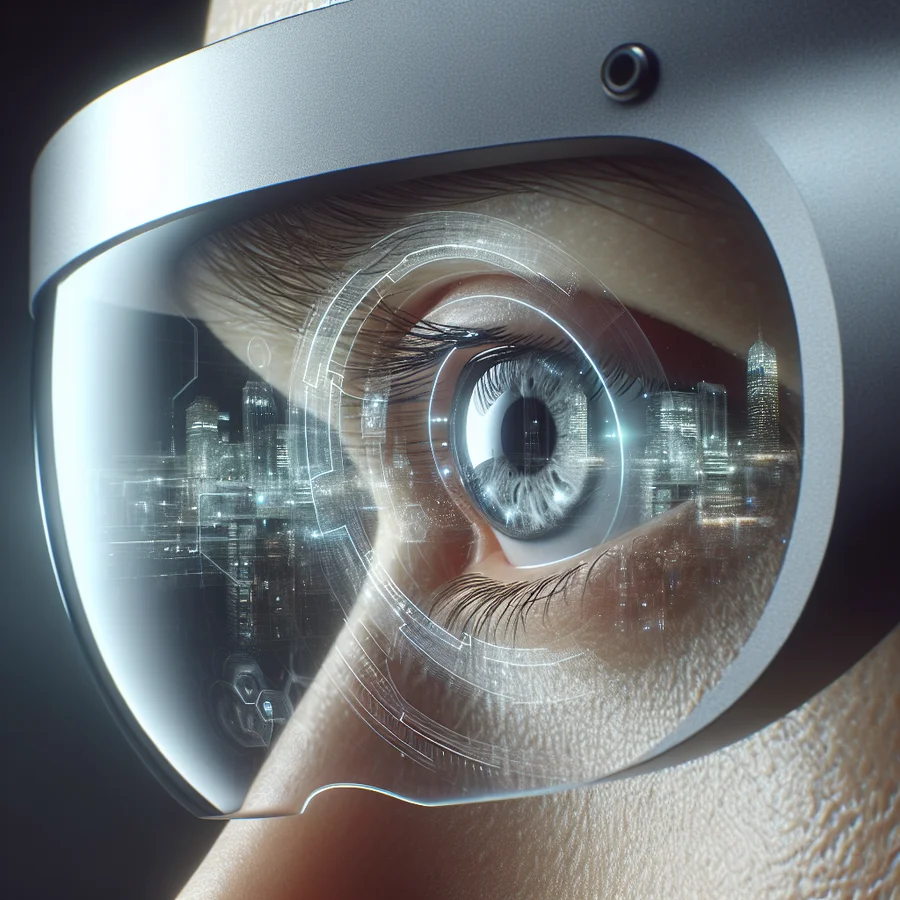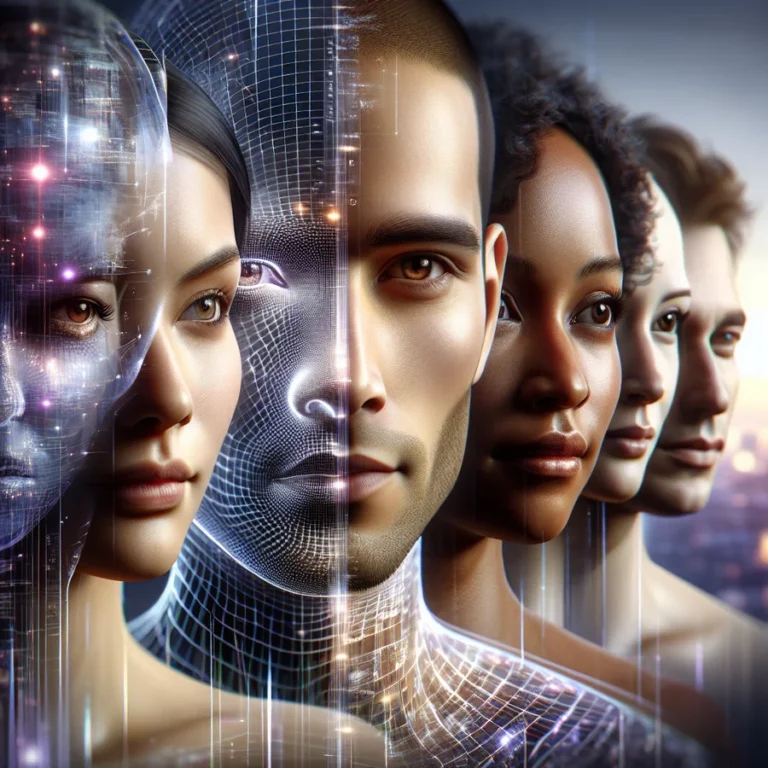AI in Augmented Reality: Enhancing Interaction and Engagement
Imagine a world where digital information seamlessly blends with your physical surroundings. That’s the promise of Augmented Reality (AR). Now, imagine AR that’s not just reactive, but intelligent, adapting to your needs and preferences in real-time. That’s where Artificial Intelligence (AI) comes in. The fusion of AI in Augmented Reality is revolutionizing how we interact with technology and the world around us, opening doors to unprecedented levels of engagement and personalized experiences.
This guide explores the exciting intersection of AI in Augmented Reality. We’ll dive into how AI enhances AR applications, transforming industries from retail and gaming to healthcare and education. We’ll also discuss the challenges and ethical considerations, and peek into the future of this dynamic field. Get ready to discover how AI is making AR smarter, more intuitive, and more impactful.
Understanding the Basics of Augmented Reality
Before we delve into the role of AI, let’s quickly recap what Augmented Reality is all about. AR is a technology that overlays computer-generated images onto the real world. Think of it as a digital layer on top of your existing reality. Unlike Virtual Reality (VR), which creates a completely immersive digital environment, AR enhances your current view.
You’ve probably already encountered AR in various forms:
- Smartphone games: Pokémon GO is a classic example, where virtual creatures appear in your real-world surroundings.
- Social media filters: Snapchat and Instagram filters that add fun effects to your face or environment.
- Shopping apps: Apps that let you virtually “try on” clothes or see how furniture would look in your home.
These are just a few examples. AR is becoming increasingly prevalent, and its potential is vast.
How AI Supercharges Augmented Reality
While AR provides the visual interface, AI provides the brains. AI algorithms analyze data, learn from user interactions, and make intelligent decisions to enhance the AR experience. AI in Augmented Reality is what makes it truly interactive, personalized, and useful.
Here’s how AI elevates AR:
- Contextual Understanding: AI enables AR systems to recognize objects, spaces, and scenarios in the real world. This allows for more relevant and meaningful augmentations. For example, an AR app could identify a specific landmark and provide historical information about it.
- Real-Time Adaptation: AI allows AR experiences to adapt dynamically based on the user’s environment, behavior, and even emotions. Imagine an AR game that adjusts its difficulty based on your skill level.
- Personalized Experiences: AI-driven AR applications can interact with users in a more natural and intuitive way. This could be through voice commands, gesture recognition, or personalized content.
Note: AI adds a layer of intelligence to AR, making it possible for AR systems to understand and interact with the environment in more sophisticated ways.
Key Benefits of AI in Augmented Reality
The integration of AI in Augmented Reality offers a multitude of benefits, transforming user experiences and opening up new possibilities across various industries. These benefits stem from AI’s ability to analyze data, learn from interactions, and adapt to individual needs in real-time.
- Enhanced Interactivity: AI allows AR applications to respond intelligently to user actions and environmental changes, creating a more engaging and dynamic experience.
- Personalized Content: AI can tailor AR content to individual preferences and behaviors, making the experience more relevant and useful.
- Improved Accuracy: AI algorithms can enhance the accuracy of object recognition and tracking, leading to more seamless and realistic AR experiences.
- Increased Efficiency: AI can automate tasks and provide real-time guidance, improving efficiency in various applications such as manufacturing and healthcare.
- New Possibilities: The combination of AI and AR unlocks new possibilities for innovation and creativity, leading to the development of groundbreaking applications across industries.
These benefits highlight the transformative potential of AI in Augmented Reality, paving the way for a future where digital and physical worlds seamlessly merge to enhance our lives.
Transforming Industries: Real-World Applications of AI in Augmented Reality
The convergence of AI in Augmented Reality is not just a futuristic concept; it’s a present-day reality that’s transforming industries across the board. Let’s explore some compelling real-world applications:
AI in Augmented Reality in Retail
Imagine shopping where you can virtually “try on” clothes, see how furniture fits in your home, or experiment with different makeup looks – all from the comfort of your couch. AI in Augmented Reality is making this a reality.
- Virtual Try-Ons: Retailers are using AI-integrated AR for virtual try-ons, allowing customers to see how clothes, glasses, or makeup products would look on them through their smartphone screens. This enhances the online shopping experience and reduces returns.
- In-Store Navigation: AI-driven AR apps assist customers in navigating stores, providing information on products and offers in real-time, elevating the shopping experience.
- Personalized Recommendations: AI analyzes your past purchases and browsing history to suggest products you might like, displayed directly in your AR view.
Example: Imagine using an AR app while browsing a furniture store. You point your phone at an empty space in your living room, and the app overlays a 3D model of a couch, allowing you to see exactly how it would look in your home before you buy it.
AI in Augmented Reality in Education
Learning becomes an interactive adventure with AI in Augmented Reality. Forget static textbooks; students can explore 3D models of human anatomy, dissect virtual frogs, or travel back in time to witness historical events – all through AR.
- Interactive Learning: AI-driven AR creates interactive educational content, making learning more engaging. For instance, biology students can explore 3D models of human anatomy in real-time, enhancing their understanding and retention.
- Customized Learning Experiences: AI tailors AR experiences to individual learning styles and paces, providing a more personalized education.
- Gamified Learning: AR games can make learning fun and engaging, motivating students to learn and retain information more effectively.
Example: A history lesson comes alive as students use an AR app to explore a virtual reconstruction of ancient Rome, walking through the Forum and interacting with historical figures.
AI in Augmented Reality in Healthcare
The precision and efficiency of healthcare are being revolutionized by AI in Augmented Reality. Surgeons can use AR to overlay crucial information like imaging scans directly onto the patient’s body, improving precision and safety.
- Surgical Guidance: Surgeons are using AI-enhanced AR for real-time, in-surgery guidance, overlaying crucial information like imaging scans directly onto the patient’s body, improving precision and safety.
- Patient Education: AR applications, powered by AI, help in explaining complex medical conditions and treatments to patients, enhancing their understanding and engagement in their care.
- Remote Assistance: AR allows experienced surgeons to remotely guide less experienced colleagues through complex procedures, improving patient outcomes in underserved areas.
Example: A surgeon uses an AR headset to view a 3D reconstruction of a patient’s tumor, allowing them to plan the surgery with greater precision and minimize damage to healthy tissue.
AI in Augmented Reality in Gaming
Gaming takes on a whole new dimension with AI in Augmented Reality. Imagine battling virtual monsters in your living room or exploring fantastical worlds that blend seamlessly with your surroundings.
- Immersive Gaming: AI in AR creates deeply immersive and interactive environments, adapting game scenarios and challenges based on the player’s behavior and preferences, offering a unique experience each time.
- Realistic Interactions: AI allows virtual characters to interact with the real world in a believable way, making the gaming experience more engaging and immersive.
- Personalized Gameplay: AI tailors the game’s difficulty and storyline to the player’s skill level and preferences, creating a more enjoyable and challenging experience.
Example: You’re playing a strategy game on your coffee table, using AR to view the battlefield and command your troops. The AI opponent adapts to your tactics in real-time, making each battle unique and challenging.
AI in Augmented Reality in Sports
AI in Augmented Reality is revolutionizing fan engagement in sports by offering immersive experiences. By overlaying virtual data on the real world, AR improves fans’ approach to engaging with a live sports match, increasing their interest in and excitement about the events.
- AR-based live streaming: Fans can experience the game while obtaining real-time statistics, watching profiles of players, and interacting with the numerous possibilities offered by the platform.
- Interactive stadium experiences: Fans can access interactive maps, concession stand menus, and virtual seat views. This immersive stadium experience enhances fans’ visits to the venue, providing them with valuable information and entertainment throughout the game.
- Social media engagement: AR filters and effects have become increasingly popular among sports teams and leagues, allowing fans to overlay virtual face paint and team logos onto their selfies.
Example: While watching a baseball game, AR can show informational elements, such as pitch speed, player statistics, or the present game score, in real-time, all on top of the stadium or TV view.
These are just a few examples of how AI in Augmented Reality is transforming industries. As the technology continues to evolve, we can expect to see even more innovative applications emerge.
Emerging Technologies in AI for AR
The field of AI in Augmented Reality is constantly evolving, driven by advancements in several key technologies. These emerging technologies are not only enhancing current AR applications but also paving the way for new possibilities.
- Computer Vision: At the heart of AI-driven AR is computer vision, enabling AR systems to accurately perceive and interpret the surrounding environment. This technology allows AR devices to recognize objects, faces, gestures, and even emotions, creating more interactive and personalized experiences.
- Machine Learning Algorithms: These algorithms are crucial in making AR experiences smarter and more adaptive. They analyze user data and behaviors, enabling AR systems to learn and evolve over time, providing more tailored and relevant content to the user.
- Predictive Analytics: AI’s ability to predict user behavior and preferences is transforming AR applications. Predictive analytics enables AR systems to anticipate what information or augmentation a user might need next, making the AR experience more intuitive and seamless.
- Spatial Computing: This emerging field combines the physical and digital worlds, enabling AR devices to understand and map the 3D space around the user. AI plays a vital role in this, processing spatial data to create more immersive and realistic AR experiences.
Reminder: Continuous advancement in AI technologies promises to keep pushing the boundaries of AR, opening up a world where digital and physical realities coalesce seamlessly.
Challenges and Ethical Considerations of AI in Augmented Reality
While the potential of AI in Augmented Reality is immense, it’s crucial to acknowledge and address the challenges and ethical considerations that come with this powerful technology.
- Data Privacy and Security: AI in AR often involves processing large amounts of personal data, including visual and spatial information. Ensuring the protection of this sensitive data against unauthorized access and breaches is paramount.
- Accuracy and Reliability: The accuracy and reliability of AI-driven AR systems are critical, especially in high-stakes fields like healthcare and public safety. Misinterpretations or errors could lead to serious consequences.
- User Safety and Health: Prolonged use of AR can lead to physical side effects such as eye strain, fatigue, and in some cases, motion sickness. Ensuring user safety, particularly when AI-driven AR experiences are increasingly immersive, is a significant concern.
- Ethical Use of AI: The ethical implications of AI in AR, such as issues of consent, user manipulation, and the creation of realistic scenarios that may have psychological impacts, need careful consideration. There’s a fine line between enhancing experiences and infringing on personal and moral boundaries.
- Accessibility and the Digital Divide: The advanced technology required for AI-driven AR is not universally accessible, potentially widening the digital divide. Ensuring equitable access to these technologies is a challenge that needs addressing to avoid creating a gap between those with and without access to these advancements.
Note: Navigating these challenges requires a collaborative approach involving technologists, ethicists, regulators, and users. Developing comprehensive standards, regulations, and ethical guidelines is crucial for the responsible advancement of AI in AR.
The Future of AI in Augmented Reality
Looking ahead, the future of AI in Augmented Reality is brimming with possibilities. We can expect even more groundbreaking changes across various sectors and aspects of our daily lives.
- Enhanced Personalization and Interactivity: Future advancements in AI are expected to drive even higher levels of personalization and interactivity in AR experiences. Imagine AR systems that not only understand user preferences but also anticipate needs and adapt content in real-time, offering a truly customized experience.
- Broader Industrial and Commercial Applications: AI-enhanced AR is poised to transform industries far beyond its current scope. In manufacturing, AR can assist with complex assembly processes, while in retail, it could revolutionize customer experiences with highly interactive and personalized shopping environments.
- Integration with Emerging Technologies: The integration of AI in AR with other cutting-edge technologies like 5G, IoT (Internet of Things), and edge computing could lead to more seamless, efficient, and powerful AR experiences. This synergy is likely to enable faster processing, reduced latency, and more robust AR applications, even in complex environments.
- Social and Ethical Advancements: As we advance, a greater focus on social and ethical considerations in AI and AR development is anticipated. This includes enhanced privacy protections, ethical AI design, and efforts to make AR technology more accessible and inclusive, ensuring equitable benefits for all.
- Revolutionizing Everyday Life: The day is not far when AI-driven AR becomes an integral part of everyday life, from enhanced navigation systems and interactive educational tools to advanced personal assistants and immersive entertainment experiences.
The future of AI in Augmented Reality is not just about technological advancements; it’s about redefining the way we interact with the world around us, enhancing our capabilities, and opening up new avenues for innovation and exploration.
Conclusion
The fusion of AI in Augmented Reality is more than just a technological trend; it’s a fundamental shift in how we interact with the digital and physical worlds. AI enhances AR experiences, making them more intuitive, personalized, and useful. From revolutionizing industries like retail, education, and healthcare to creating new possibilities for gaming and entertainment, the impact of this synergy is undeniable.
While challenges and ethical considerations must be addressed, the future of AI in Augmented Reality is bright. As technology continues to evolve, we can expect even more innovative applications to emerge, transforming our lives in ways we can only imagine. The journey has just begun, and the possibilities are limitless.
FAQs About AI in Augmented Reality
What is the main difference between AR and VR?
AR overlays digital information onto the real world, enhancing the user’s perception of their environment. VR, on the other hand, creates a completely immersive digital experience, replacing the real world with a simulated one.
How does AI improve AR experiences?
AI enhances AR by providing contextual understanding, enabling real-time adaptation, and personalizing content based on user preferences and behavior. This makes AR experiences more interactive, relevant, and engaging.
What are some ethical concerns related to AI in AR?
Ethical concerns include data privacy and security, accuracy and reliability of AI systems, user safety and health, potential for user manipulation, and the widening of the digital divide due to unequal access to technology.
What industries are currently being transformed by AI in AR?
Several industries are being transformed, including retail, education, healthcare, gaming, and manufacturing. Each industry is leveraging AI in AR to improve efficiency, enhance user experiences, and create new opportunities.
What emerging technologies are driving the development of AI in AR?
Emerging technologies include computer vision, machine learning algorithms, predictive analytics, and spatial computing. These technologies enable AR systems to better understand and interact with the real world, leading to more immersive and realistic experiences.






